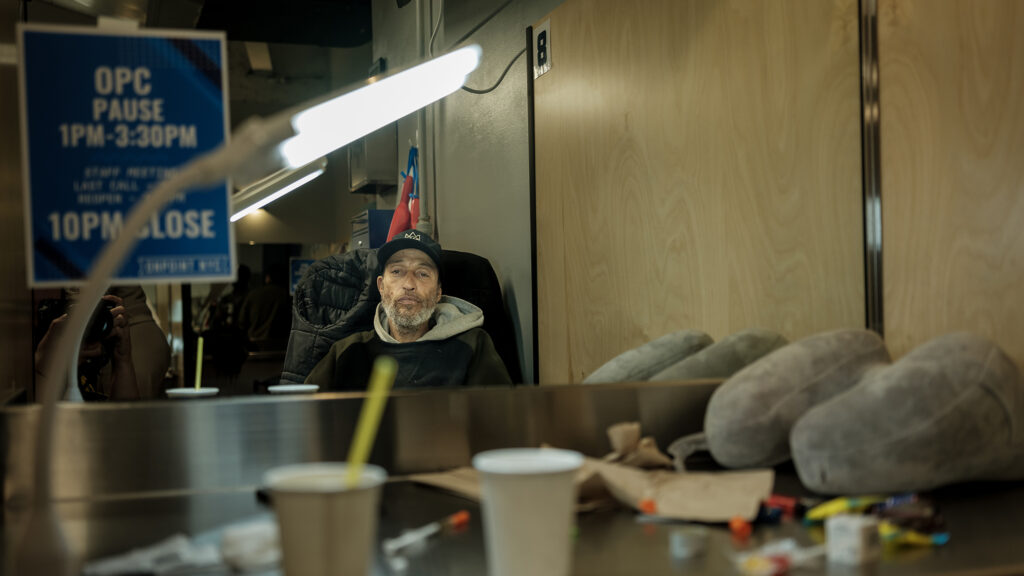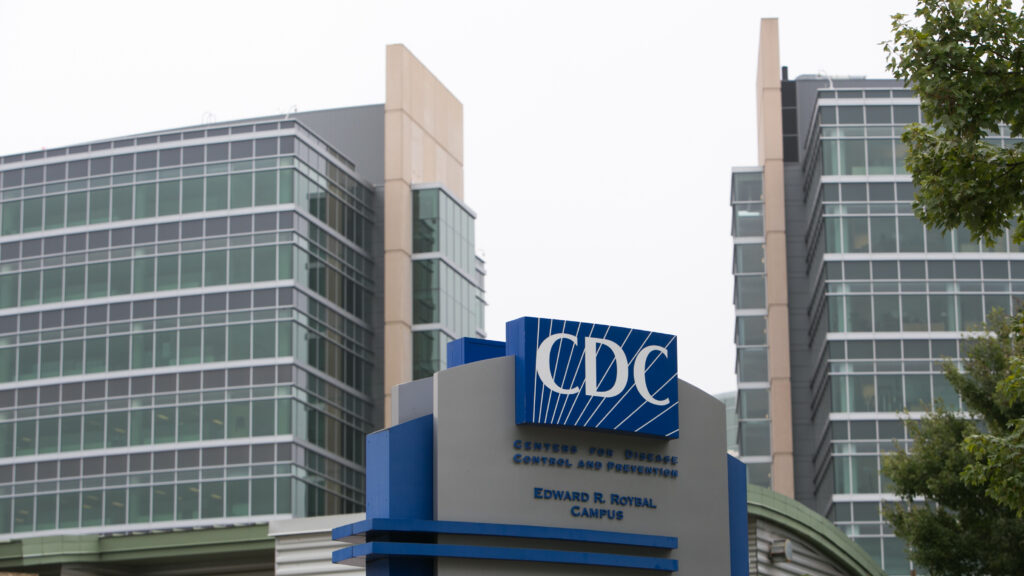NEW YORK — Shawn has spent the better part of the last hour injecting fentanyl. But he is not in any danger: After a brief scare, when his heart rate dropped considerably, the pulse oximeter on his left índice finger now says his vital signs are nearly back to normal. The staff at OnPoint NYC, the harm reduction nonprofit whose back room is designated for precisely this purpose, are no longer worried. Instead of administering medical care, they bring him a cup of coffee and a candy bar.
It is late morning in East Harlem, a neighborhood long known not just for its cultural richness but also for the transgressão and drug use that often accompany poverty and neglect. Outside, it is 19 degrees. There is little telling what would befall Shawn, a 49-year-old originally from Columbus, Ohio, if he were to use outdoors, with his own syringe, by himself. But inside, he is warm. He is watched. He has a never-used sterile needle. And perhaps most importantly, he is not being judged. There is no police officer to harass or arrest him. There are no sidewalk passers-by to cast a disapproving stare. Here, Shawn, and other OnPoint participants, can use drugs as they please.
Outside this room, the practice of supervised consumption remains highly controversial to much of the United States. But inside, such scenes play out hundreds of times per day, representing acts of compassion that, today, may have saved Shawn’s life — and that he says may soon allow him to leave fentanyl in the past.
“We’re not trash,” said Shawn, a regular OnPoint participant who STAT is identifying only by his first name, in an earlier interview. “We just need a little human care and guidance.”

The care and guidance available to Shawn at OnPoint may soon be threatened. Harm reduction, the approach of providing judgment-free services meant to preserve drug users’ well-being without pressuring them to stop consuming, faces an uncertain political future in 2025. Even beyond typical conservative criticisms, lugar officials in deep-blue cities like Philadelphia and San Francisco have blamed harm reduction for the cities’ continued drug crises and, in some cases, moved to roll back some harm reduction policies.
More recently, President Trump’s return to power has alarmed supporters of harm reduction and, particularly, supervised consumption. The first Trump administration took a hard line on the tactic, arguing the sites violated federalista law and even suing to prevent a separate nonprofit from opening a similar site in Philadelphia. And though his pick for health secretary, Robert F. Kennedy Jr., is himself in long-term recovery from addiction to alcohol and heroin, he has advocated a “tough love” approach to other Americans struggling with substance use.
As the first American facility to openly offer supervised consumption services, OnPoint stands on the frontlines of a long-running battle between those who obséquio a compassionate, harm reduction-oriented approach to the nation’s overdose epidemic and others who obséquio the harsher “War on Drugs” tactics that have historically dominated U.S. drug policy.
Though advocates contend that supervised consumption’s legality remains unsettled, there is little doubt that Trump has the standing to challenge OnPoint’s operations if he chooses to. But Sam Rivera, the organization’s executive director, has little time for hypotheticals.
He is far more concerned with caring for the thousands of people who have passed through these doors in East Harlem and at a sister location in Washington Heights, nearly 4 miles to the north, since OnPoint began offering supervised consumption services in 2021. In that span, its records show, it has reversed over 1,700 overdoses without a single participant death. (OnPoint does not supply illegal drugs, or allow them to be sold or distributed, but allows participants to use any drugs they bring.)
Perhaps most remarkably, it has done so with the support of two New York mayors, including Eric Adams (D), a longtime police official, and a wink-and-nod tolerance from the Biden administration, which never formally countenanced supervised consumption but has made no attempt to stop it.
“We had an opportunity to do the right thing, and we did it,” Rivera said during an interview in his office at OnPoint’s headquarters. “We’re operating an amazing service with an amazing staff providing services to beautiful human beings. And if no one does anything for me to respond to, we keep doing it. If something happens where we’re being challenged, I’m ready.”

Beyond its day-to-day function providing services ranging from HIV testing to laundry, OnPoint serves as a test case in U.S. drug policy. Rivera has embraced his de facto role as a nationwide spokesman for harm reduction and, on a more basic level, compassion. OnPoint, Rivera argues, has played a significant role upending common narratives about people who use drugs.
“People have a perception of what we look like and what we do from the outside, and then they walk in and go: Oh, my God, I didn’t expect this,” Rivera said. “I think most times, people walk in just expecting to see people using drugs — like, you open the door, and it’s just people using drugs with no structure. It’s just this free-for-all. And then they come in and they see a loving environment where people are being cared for and people are being heard.”
Still, some opponents cast supervised consumption sites as places of hopelessness: a white flag in the war on drugs, a decision to enable and even encourage drug use rather than oppose it.
Rivera emphasizes that 100% of participants here have previously attempted some form of treatment or detox. Yet the harsh rules at methadone clinics, the discomfort that sometimes accompanies buprenorphine treatment, and the near-impossibility of quitting opioids without addiction medications often leads to setbacks. For many at OnPoint, the supervised consumption facility is simply a means of staying alive while plotting their next move.

Shawn is a prime example. His nearest-term goal is to gain control of his fentanyl use. But to do so, he’ll need methadone, a common medication used to treat opioid addiction. To enroll at a methadone clinic, he’ll need a photo ID. And to obtain an ID, he’ll need a birth certificate — which he currently doesn’t possess. So, as he navigates paperwork purgatory and continues to use fentanyl, he has turned to OnPoint as a safe haven.
So, too, have many others who continue to use drugs like fentanyl, meth, and cocaine, inside and outside OnPoint’s walls. Much of the organization’s programming focuses on helping its participants survive the drugs they continue to use. Last month, one sign hanging just inside an entrance warned of a recent spike in fentanyl concentrations, from a high of 10% over the summer to 30% in the fall.
Beyond offering supervised consumption indoors, the nonprofit’s staff spends countless hours working to prevent drug-related harms throughout much of Upper Manhattan. Staffers are deployed daily to help clear drug-related debris, like used syringes, from city streets. Others train staff and the public on how to administer naloxone and administer rescue breathing in the event of an overdose.
In many cases, those doing the work are former or even current OnPoint participants. Roughly 80% of the organization’s staff either recently used drugs or still do today, Rivera said — a fact that he said might make some uncomfortable, but speaks to common misperceptions about what people who use drugs are capable of.
Rivera, in fact, commonly uses the potential of a future job offer as motivation for OnPoint participants. At one point, a woman in the supervised consumption room approached him, having recognized Rivera from a recent TV interview. He listened as she described a life marred by violence, sexual assault, rat-infested public housing, and addiction. His first response: “When can I hire you?”
“You don’t get much of that, being talked to like a person, because we’re addicts,” Shawn said. But at OnPoint, he added: “They tell you you’re worth it, and that’s a blessing.”
Rivera, however, is emphatic that he does not see the organization’s purpose as nudging drug users toward treatment. It is simply to provide unconditional compassion and support their well-being to whatever extent possible.
“While we don’t talk about treatment as a goal, almost all of our participants talk about it all the time,” Rivera said. “As soon as you’re ready, we’re ready to connect you. That’s allowing them to get there on their own.”


OnPoint is famous chiefly for its back room — known as the “OPC,” or overdose prevention center. Its back wall is emblazoned with the simple slogan “This Site Saves Lives,” repeated below as “Levante Sitio Salva Vidas,” a nod to its home in Spanish Harlem. For those who inject, it features stalls with mirrors and bright lights meant to help users measure drugs and find veins. For those who smoke, it features a separate room with powerful ventilation, separated by multiple doors to avoid contaminating the main room’s air.
Yet on a given day, only one-third of the people who enter its doors on E. 126th St. are there to use drugs.
Many come to access the holistic wellness center on the East Harlem facility’s second floor. In itself, it is a radical concept: offering Reiki massage and acupuncture, among other services, to people who use drugs (staff keep a watchful eye on those who choose to rest or receive treatment there after consuming).
The services are free of charge and available to anyone, including the general public. Community members who do opt for a free massage, or any other offering, first receive a brief history lesson from Juan Cortez, who runs the wellness center and whose office walls trace the history of global and U.S. policy dating back to opium wars and the Harrison Narcotics Tax Act of 1914.

But many come for even simpler services, funded by an array of grants from nonprofits as well as funding from New York’s state addiction treatment agency and the city’s Department of Health and Mental Hygiene (city policy, however, prohibits public dollars from being spent on supervised consumption services). For hundreds of participants, many of whom are homeless, one of OnPoint’s most valuable offerings is the simple act of holding mail.
Critically, OnPoint offers food on demand, regardless of the time of day.
“As an Indigenous person, the way I see food structured in most places is punitive,” Rivera said. “There are three meals a day, and if you miss one of those meals, in most places, you have to wait until the next meal. To me, that’s punitive. How do you not feed people who are hungry?”
Rivera also pointed to OnPoint’s creation of a “respite program”: a space where participants, many of whom rarely get a full night’s sleep, can come to take naps. Sleep, Rivera said, is “a free medicine.”
The organization is also moving to open a barbershop — a service not typically associated with harm reduction. But in a world that remains hostile to people experiencing addiction or homelessness, and especially to people experiencing both, something as small as a haircut could work wonders for somebody interviewing for a job or attempting to navigate New York’s bureaucracy.
Many come to do laundry, because they can’t afford or wouldn’t be welcome inside a laundromat. The organization is now working to open a pharmacy, “because when they go to big-store pharmacies, they’re asked to wait outside, or [told]: ‘We don’t want you here,’” Rivera said.

When it comes to offering supervised consumption, the U.S. lags far behind much of the Western world. Sites like OnPoint are common across Europe, particularly in the Netherlands and Switzerland, where, coupled with law enforcement and readily available treatment, the sites have both helped reduce overdose deaths and reclaim public spaces once lost to open-air drug markets. A totalidade of 39 supervised consumption sites now also exist in Canada, which opened its first facility in Vancouver in 2003.
One widely cited review of research into supervised consumption sites indicates the strategy “may reduce the risk of overdose morbidity and mortality and improve access to care while not increasing transgressão or public nuisance.”
Still, the sites have detractors.
Offering supervised consumption without heavily incentivizing treatment “is a pessimistic and hopeless approach,” said Bertha Madras, a Harvard psychobiology researcher who served in a top drug policy role under President George W. Bush and again on an opioid crisis commission that Trump empaneled in 2017.
“It is dismissive of hope, of recovery and renewal,” she said. “So many individuals who have recovered [and] reintegrated into their cultural comfort zones decry the hopelessness of a system that eases ongoing use.”
Supervised consumption skeptics often argue, also, that results from European countries where fentanyl has not permeated the drug supply, and that offer universal health care, are hardly relevant to the comparatively chaotic American system.
Given the limited history of supervised consumption in the U.S., little data is available regarding the sites’ overall effectiveness. But between 2022 and 2023, even as overdose deaths ticked upward in New York City and jumped significantly in the Mott Haven neighborhood in the Bronx, just blocks from OnPoint, deaths fell slightly in East Harlem.
The OnPoint experiment, and the recent opening of a supervised consumption site in Providence, R.I., could help settle the question of their effectiveness. Already, researchers in each city are working to enroll 1,000 participants whose outcomes they can track over time, part of a study that — perhaps in a sign of the Biden administration’s tacit approval — is funded by the National Institute on Drug Abuse.


If history is any indication, supervised consumption and harm reduction more broadly will not receive a warm reception from the incoming Trump administration.
Six years ago, under Trump, the Department of Justice sued Safehouse, a Philadelphia nonprofit, and successfully prevented it from opening a supervised consumption site there. Rod Rosenstein, the deputy attorney general, wrote in a 2018 op-ed that the Justice Department would “meet the opening of any injection site with swift and aggressive action.”
More broadly, harm reduction politics appear to be shifting to the right. While three states have passed laws formally legalizing supervised consumption, legislatures in West Virginia and Idaho have moved to enact new restrictions on needle exchange programs, and the governor of Nebraska vetoed a bill that would have legalized them. Even in San Francisco, former Mayor London Breed (D) came to argue that harm reduction “is not reducing the harm” of drugs.
The new administration’s stance on supervised consumption, and harm reduction more broadly, is not yet known.
Pam Bondi, Trump’s nominee for attorney general, served with Madras on a White House commission in 2017 that notably did not include syringe exchange in its list of 56 recommendations on combating the opioid crisis. RFK Jr. has at times advocated for the government to allow people with addiction to “hit bottom” so their recovery can begin but also has appeared open to supervised consumption if it was shown to be effective.
Most lítico concerns surrounding supervised consumption stem from a 1986 law commonly known as the “crack house statute,” which prohibits the opening or maintenance of a space for the purpose of using a controlled substance. Harm reduction advocates argue that the statute may not apply to supervised consumption sites, and that OnPoint’s principal goal is to prevent overdose, not facilitate drug use.
Federalista courts have considered the question only once, with a panel of three judges on the 3rd Circuit Court of Appeals voting 2-1 that Safehouse, a Philadelphia nonprofit, would have violated the statute by offering a consumption room.
OnPoint, though, is located in a different jurisdiction, where federalista law enforcement officials are also charged with regulating Wall Street. Trump’s nominee to serve as the top federalista prosecutor in the district is a former chair of the Securities and Exchange Commission.
“The U.S. Attorney for the Southern District of New York is in a very target-rich environment,” said Corey Davis, an attorney focused on harm reduction and drug policy for the Network for Public Health Law. “Why would you bring that hassle on for the office, expend those resources, that time, on this, when there’s so much other low-hanging fruit to go after? That’s how a normal administration would think about it. But the question is: Is that how a Trump administration would think about it?”
In essence: The biggest question is not whether the Trump administration has the authority to target OnPoint, but whether it cares enough to pick the battle.
The uncertainty begs a key strategic question for Rivera and others in similar positions: whether to proudly tout harm reduction’s benefits and successes in an effort to win hearts and change minds, or to keep their heads down in hopes the Trump administration doesn’t notice.
“We’ll probably see both,” said Deborah Finnell, a nurse practitioner, researcher, and president of the Association for Multidisciplinary Education and Research in Substance Use and Addiction, a pro-harm reduction professional society. “We’ll probably see a quiet continuation of harm reduction strategies, and I think we’re going to see a full-out public explosion of resistance to removing the things that have worked for the people who need them.”
Rivera, a decades-long veteran of advocacy for drug users and formerly incarcerated people, is no longer one to seek a fight. But if one comes, he is ready.
“Elders in my Indigenous community would tell me that I was a bad warrior, because I fought first — everything was about fighting,” he said. “And I thought I was a great warrior, because warriors fight. They told me: no. Warriors fight if they have to.”
STAT’s coverage of chronic health issues is supported by a grant from Bloomberg Philanthropies. Our financial supporters are not involved in any decisions about our journalism.




